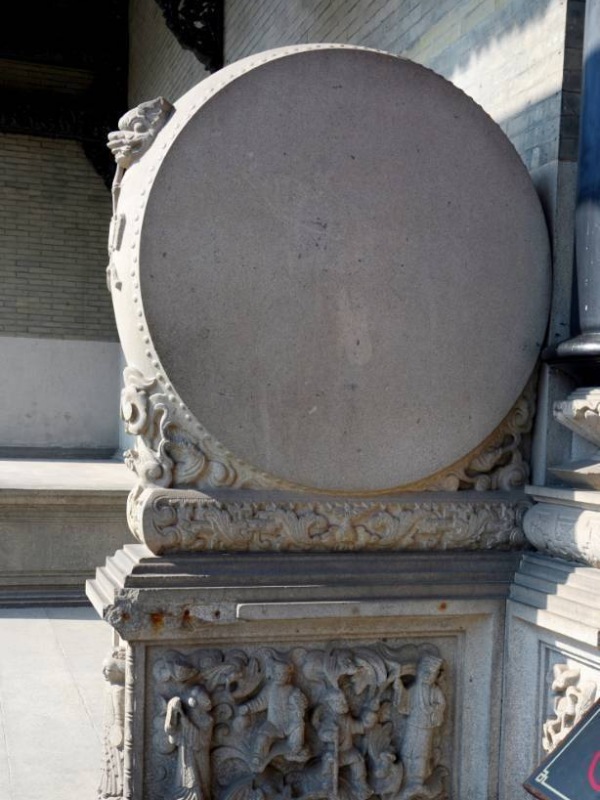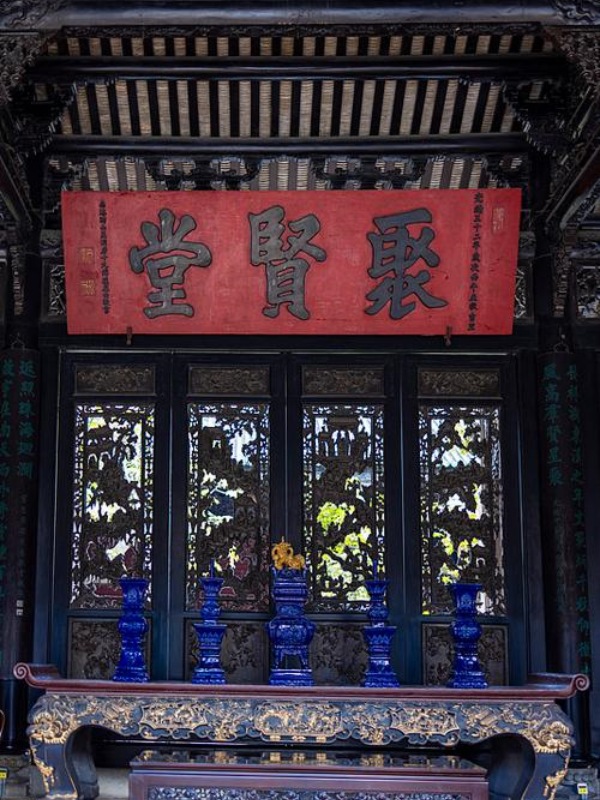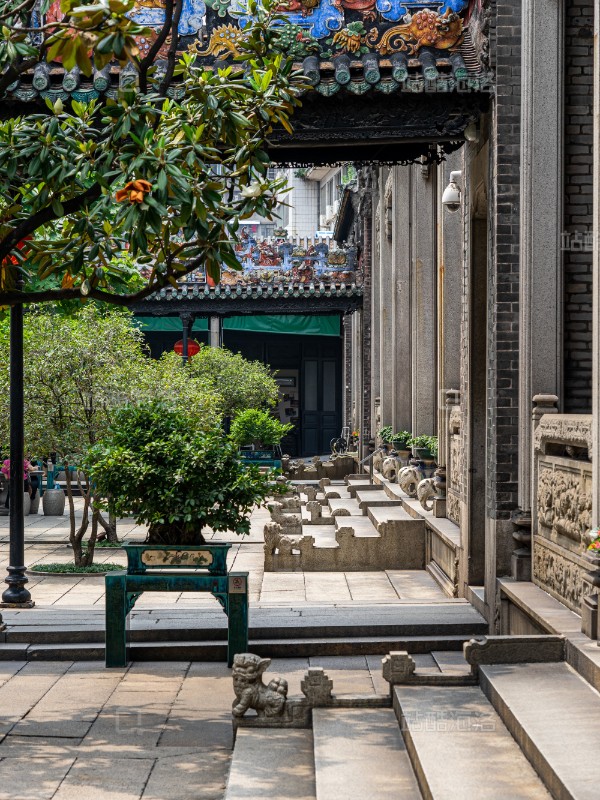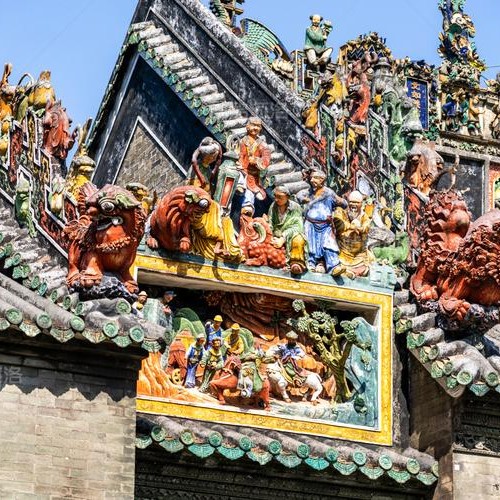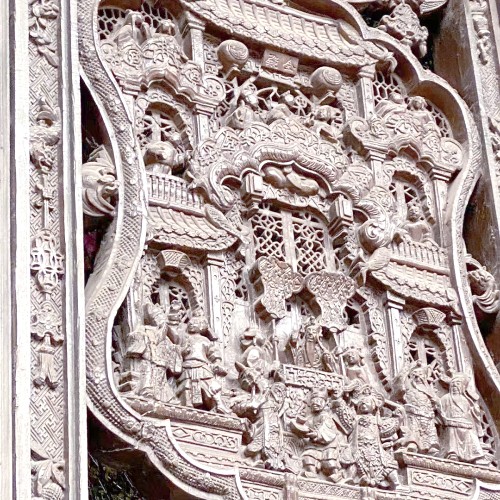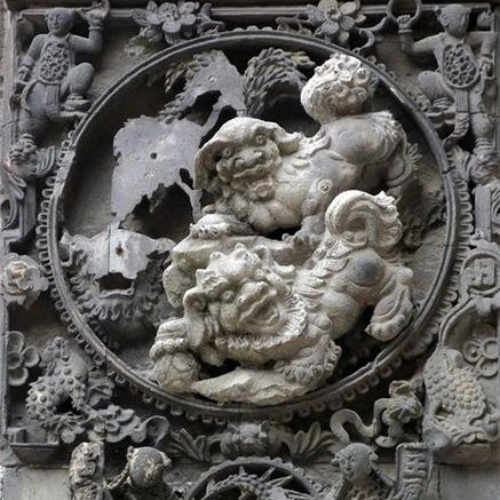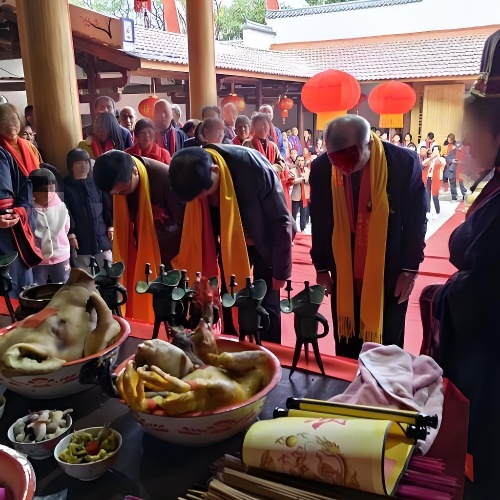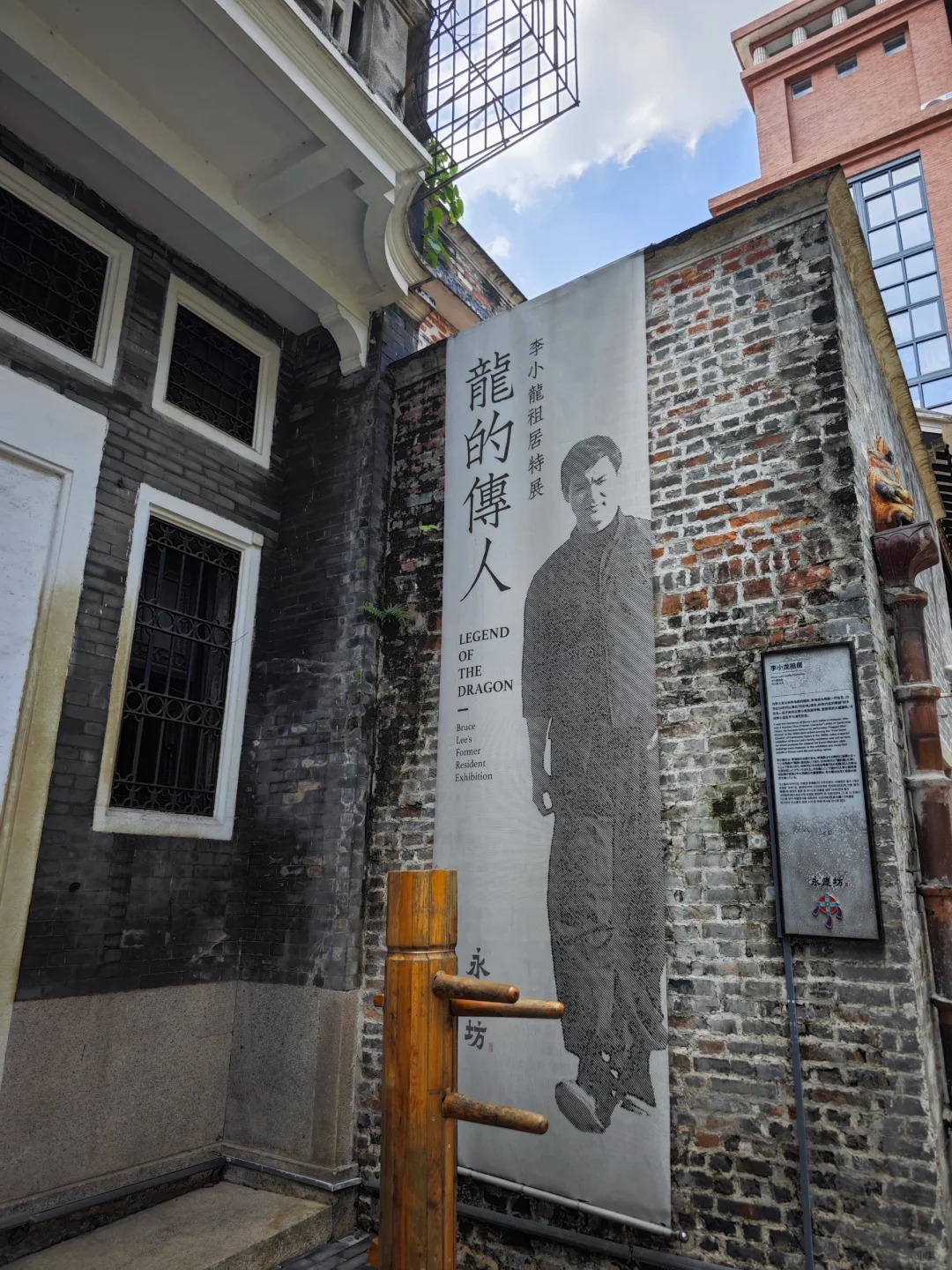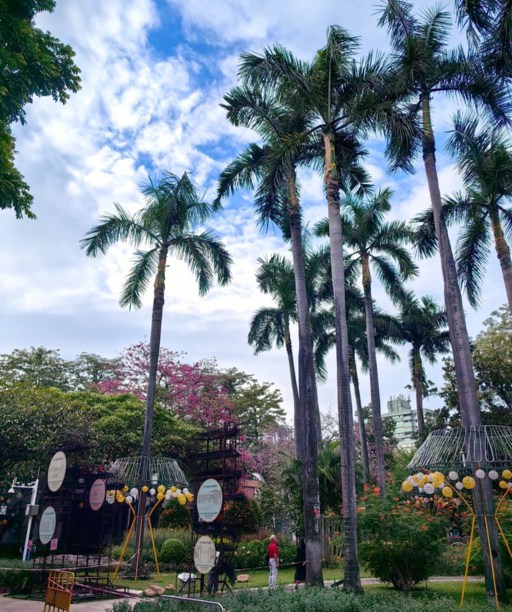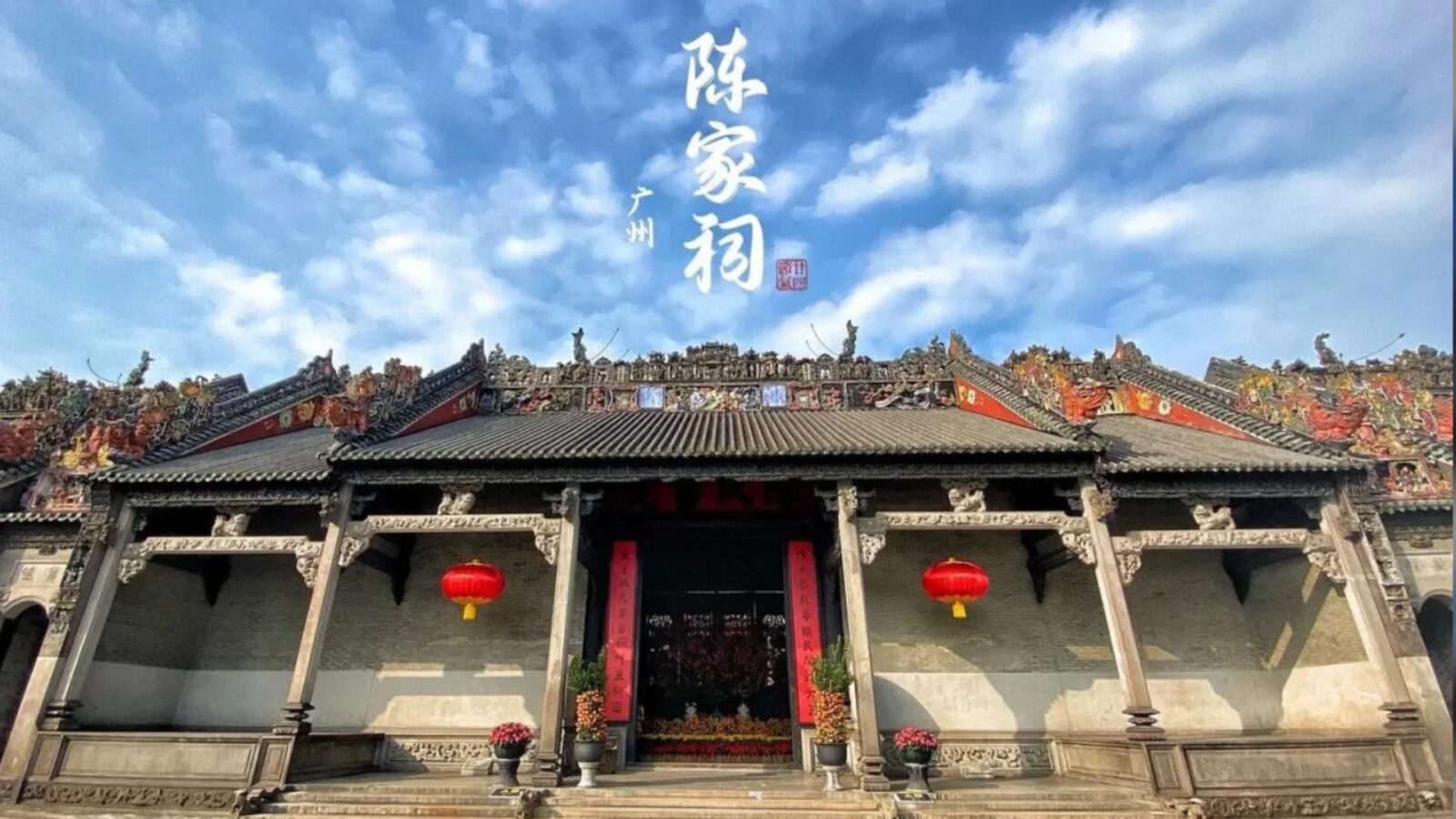 It is easy to pass by without a second glance, yet behind its unassuming facade hides this large compound built at the end of Qing Dynasty by Chen clan members from 72 counties across Guangdong province. As well as being a place of worship, Chen Clan Ancestral Hall Guangzhou (陈家祠) was designed to serve many other purposes--its function is absolutely unique in all of China's historic sites.
It is easy to pass by without a second glance, yet behind its unassuming facade hides this large compound built at the end of Qing Dynasty by Chen clan members from 72 counties across Guangdong province. As well as being a place of worship, Chen Clan Ancestral Hall Guangzhou (陈家祠) was designed to serve many other purposes--its function is absolutely unique in all of China's historic sites.
The significance of this historical site lies in its unique combination of three features. Ancestral worship for the clan, a place to hold any business, and an academy where young Chens prepared for imperial exams -- the ancient Chinese "civil service tests. "However, what stands out more than anything at all, is that it is the essence of Lingnan architecture in which one finds the famous "Seven Treasures" of arts: exquisite pottery ridge crests; rafts of wooden carving vertically deep-cut; tackling brick carvings with so much detail.
In the twenty-odd structures linked by corridors and cloisters here, the beams and panels have their own tales to tell about how unity of clan and mutual help have kept it going for so long. Hence we will guide you through its most significant architectural features, explain exactly what each piece of art represents, tell you why this was originally a clan headquarters and give logistical advice based on our years of experience-- including tips for getting the most out of your timing and finding complementary sites nearby. Please read on to make your visit to this unique piece of heritage an unforgettable journey into Guangzhou's history.
Chen Clan Ancestral Hall Uncovered: Everything You Need to Know
Address: No.34 Enlong Li, Zhongshan 7th Road, Liwan District, Guangzhou, Guangdong Province, China
Type: National Key Cultural Relics Protection Unit & National First-Class Museum (Guangdong Folk Art Museum)
Historical Positioning: Built 1888-1893 by Chen clans from 72 Guangdong counties; unique triple function: ancestral shrine, clan meeting hub & imperial exam preparation academy.
Core Highlights: Lingnan architecture; 'three entrances, three corridors, nine halls'; six courtyards; 'Seven Treasures' crafts; 27m pottery ridge crest; 224 figures; 16 3D wooden screens; 'Liu Qing Taming the Fiery Steed'; 20,000+ folk art relics.
Step Inside the 19 Halls—Feel, Hear, and See History Unfold
- Stone Drums
- The Gathering Hall
- Courtyards
The Entrance Hall—Stone Drums and Temperature Drop
Those 2.25-meter drums grab attention first. I'm 5'9" and they came past my head. You can touch them—feel grooves worn smooth by 130+ years. The entrance spans 27.56 meters, supported by seventeen columns painted with fading flowers. Step inside and temperature drops—natural AC. Street noise fades to footsteps and camera clicks. Look up: beams decorated with flowers, bats (luck symbols), geometric patterns. No nails—pure joinery.
The Gathering Hall—16 Carved Wooden Screens
The Gathering Hall (聚贤堂) measures 27.84 meters wide, held by twenty-one beams and six columns. The sixteen wooden screens are showpieces—not flat reliefs but three-dimensional sculptures, two meters tall, carved on both sides with classical Chinese literature scenes. Front shows Romance of the Three Kingdoms battle, flip around for different story.
I zoomed with my phone—individual facial expressions visible. One angry, one worried, one laughing. Robes carved so finely you almost see fabric moving. The wood is camphor or nanmu, chosen to resist insects. After 130 years, darkened to deep brown but hasn't rotted.
Courtyards—The Breathing Space
Chen Clan Hall is nineteen structures connected by corridors with six courtyards throughout. These "Qingyun alleys" (青云巷) create rhythm: inside hall, outside to courtyard, through corridor, another hall. Never claustrophobic. Natural ventilation flows through.
Spring (late March-April) brings yulan magnolia blooms—white flowers against gray stone. I visited October so missed it, but photos online look striking.
Curious about the artistry behind Guangzhou’s most elegant temple? Exploring the Chen Clan Ancestral Hall: A Cultural Gem in Guangzhou brings its legacy to life.
Unlocking the 'Seven Treasures'—Can You Spot Every Hidden Masterpiece?
Pottery Ridge Crests—224 Figures on Rooftops
Look up—pottery ridge crests run along roof peaks, eleven total. The largest: 27 meters long, 2.9 meters high, 224 figures in opera scenes. Each 20-30 centimeters tall, glazed bright colors—reds, blues, greens, golds. Warriors on horseback, celestial beings on clouds, mythical animals, crowd scenes. It's theatrical performance frozen on a roof.
At ridge tips: ao fish (鳌鱼), dragon-fish hybrids. Traditional beliefs said they prevented fires. Here's the catch: really high up. Even with good zoom, hard to see details from ground level. I used 10x phone zoom. Binoculars help if you're serious.
Wood Carvings—Guangzhou Craftsmanship
Guangzhou had a reputation for China's finest wood carvers. The Cantonese style (广东木雕) features extremely fine detail, multiple layers creating depth, narrative scenes. The Gathering Hall screens exemplify this. Warriors fighting on boats, waves crashing, flames, commanders watching. Each element carved separately then assembled—multi-layer diorama.
This isn't relief carving. It's fully three-dimensional. Craftsmen carved pieces five millimeters thick without splitting wood—skill plus right wood like camphor, dense enough for details but workable.
Brick, Stone, and Stucco
Most visitors focus on wood and pottery. But there's extensive brick carving, stone carving, stucco relief. Most famous brick carving: "Liu Qing Taming the Fiery Steed" on east wall—over forty figures plus horse plus background, carved into gray bricks. Brick is brittle—mistakes permanent. This survived 130+ years.
Stucco reliefs: 2,562 meters total throughout—roof bases, corridor walls, gable tops. Lime, clay, crushed shell mixture molded then painted. Less durable than pottery, so much degraded or got replaced. They're colorful but often high on walls, hard to appreciate from ground level.
Guangzhou’s charm doesn’t stop at Chen Clan Hall — THE TOP 15 Tourist Attractions in Guangzhou: Best Time to Visit 2025 uncovers the city’s full beauty.
The Soul of the Clan: What the Chen Family Hall Really Meant
If you’ve ever stood in front of Chen Clan Hall and wondered, “Why build something this grand just for ancestors?”, you’re not alone. The answer lies deep in how southern Chinese families once worked together—not just to remember the dead, but to survive and stay strong as one giant team.
What Makes the Hall Feel So Alive?
Back in the 1800s, the Chen family wasn’t one single family—it was thousands of them scattered across Guangdong. But they needed a center, a place that said, we belong together. Think of it as a mix between a family headquarters, a temple, and a university. People came to worship their ancestors, settle disputes, and raise funds to help young relatives chase imperial exam dreams. The Qing Dynasty was big on the Confucian idea of honoring your roots, so everything—every ritual, every meeting—was about keeping that moral compass alive. Some say it worked like a moral Wi-Fi: everyone connected to the same source of values.
Ever Seen a Ceremony That Feels Like a Family Reunion?
Twice a year, around spring and autumn, the Chens held huge ancestor worship events. Imagine hundreds of relatives coming from all over, carrying cooked meats and wine as offerings, bowing in order of age while elders recited long family memorials. These weren’t gloomy affairs—they were full of pride and reunion energy. When someone passed the imperial exams, he had to come back, bow to the ancestors, and throw a feast. It was a way of saying, “We did this together.” Kind of like when a whole village cheers for the first kid who makes it to university. Every ritual made sure the next generation remembered whose shoulders they stood on.
Why Did These Customs Matter So Much?
Here’s the part that really hits home: these weren’t just sentimental traditions. In a time before social insurance or hotels, the ancestral hall was where a traveling clan member could sleep, eat, or get help. If you were sick or broke, the hall had your back. It also gave scholarships to smart kids so they could take the imperial exams. Think of it as an early version of a social network—except offline and built from shared trust. That’s how Chen Clan Hall got funded by Chens from 72 counties. Every brick was paid for by someone who believed that helping one was helping all.
So when you walk through the courtyards today, don’t just see carvings and tiles. You’re standing inside a living story about how people looked out for each other long before modern systems existed. For foreign visitors, it’s one of the most human—and surprisingly familiar—stories China has to tell.
Before You Go: The Tips Locals Wish You Knew
Best Time to Visit (and When to Avoid)
Avoid weekends—my Saturday afternoon had packed courtyards. Tour groups, families, photographers everywhere. If you want to examine carvings without dodging elbows, skip Saturdays and Sundays.
Go weekday mornings. Opens 8:30 AM, first hour or two is quiet. By 10 AM, school groups arrive.
Chinese public holidays are brutal: National Day (October 1-7), Spring Festival (January-February), Labor Day (May 1-3). If you must visit during holidays, arrive at opening.
Seasons: Spring (March-May) is pleasant—warm not scorching, magnolias bloom. Summer (June-August) is hot and humid. Autumn (September-November) offers cooler temps, less rain—my favorite. Winter is mild.
Lighting: Late morning (9:30-11 AM) brings most natural light. Mid-afternoon, courtyards are shadowed.
Tickets, Metro, and the 10-Minute Walk Mix-Up
This section covers how to get in, when to go, and what to expect before stepping through those stone drums. See the table below for a quick summary of tickets, hours, and transport details.
| ItemDetails | |
|---|---|
| Entrance Fee | 10 RMB per person; includes all halls and Guangdong Folk Art Museum exhibitions. Tickets sold inside main gate or via Ctrip (lines usually <5 min). |
| Operating Hours | Tickets stop at 5:00 PM; complex closes 5:30 PM. Allow at least 1.5 hrs for main halls, 2–3 hrs for full visit. |
| Metro Access | Line 1 → Chen Clan Academy Station (陈家祠站), Exit D. Two‑minute walk to main entrance on Zhongshan 7th Road. |
| Navigation Tip | Main gate—with stone drums—is on Zhongshan 7th Road. Ignore app pins showing side/back entrances. Look for red walls and traditional roof. |
| Driving / Parking | No dedicated parking. Limited street or public lots; expect 15–20 min search. Metro strongly recommended. |
How Long You'll Actually Spend (Based on Your Interest Level)
Realistic breakdown by visitor type:
Quick walk-through (45 minutes-1 hour): Hitting main highlights—Entrance Hall, Gathering Hall, Back Hall, one or two courtyards—if you're just checking boxes. You'll get general atmosphere, snap photos, move on. This was my first visit. I missed a lot.
Standard visit (1.5-2 hours): What I recommend for most people. Time to walk through main buildings at relaxed pace, examine wood carvings without rushing, look at pottery ridge crests, wander courtyards, maybe check one or two museum rooms. You won't see everything but you'll hit major highlights and feel you got value.
In-depth tour (2.5-3 hours): If you're into architecture, crafts, or Chinese history. Explore side buildings, read museum placards (some have decent English, some don't), look for brick carvings and stucco reliefs, sit in courtyards. My second visit took nearly three hours and I still felt I could stay longer.
Photographer's marathon (3+ hours): Waiting for optimal light, testing angles, capturing carving details. One guy with professional gear told me he'd been there since opening, planning to stay till noon. That's four hours easily.
With kids: Factor shorter attention spans. Young children might find halls interesting for thirty minutes before getting bored—not much is interactive. Courtyards give space to move. Maybe an hour to ninety minutes before they're ready to leave. Also note: there are stairs. Not tons, but some halls are raised above courtyard level. Not strenuous, but if you or someone with you has mobility issues, be aware. I didn't see elevators.
Make It a Day in Liwan—Where to Go After the Chen Clan Hall

Shangxiajiu Pedestrian Street
Shangxiajiu Pedestrian Street (10-Minute Walk)
Ten minutes away: Shangxiajiu Pedestrian Street (上下九步行街), old Guangzhou commercial area. Arcade-style buildings, shops, restaurants, street food. Shows what old districts looked like pre-mall era.
Chen Tianji (陈添记) is famous for fish skin (鱼皮)—actual fish skin, cold with sweet sauce. Acquired taste. Slippery, chewy, mild flavor. If adventurous, try it.
Walk: exit main entrance, turn right onto Zhongshan 7th Road, walk west. Crowded evenings. Good for lunch after the hall.
Pearl River Evening Cruise (20-Minute Metro)
Pearl River cruise: about 20 minutes by metro to Haizhu Square (海珠广场). Line 1 eastbound to Gongyuanqian (公园前), transfer Line 2, one stop to Haizhu Square.
Hour-long cruise passes Canton Tower, bridges, high-rises. Night lighting—tower color shows, bridges glow, skyline reflects. Basic tickets 38-58 RMB outdoor deck, 100-150 RMB indoor cabin. Book Ctrip or pier vendors.
Pleasant if you've never done it. Not mind-blowing but decent way to relax after walking. Breeze off river is refreshing.
Combo itinerary: Hall morning/early afternoon (2-3 hours), lunch Shangxiajiu, maybe hotel break, river cruise early evening. Done by 8-9 PM.
FAQ: Practical Questions About Chen Clan Ancestral Hall Guangzhou
Q: What is the Chen Clan’s Ancestral Hall?
It’s both a historical site and a museum in Guangzhou. Originally built by the Chen family from 72 counties during the Qing Dynasty, it was used for ancestor worship and preparing candidates for imperial exams. Today it’s known as the Chen Clan Academy or Chen Clan Ancestral Hall. You’ll find wood carvings, ceramic decorations, and Lingnan-style architecture. The site now houses the Guangdong Folk Art Museum, so you can also see rotating exhibitions of crafts and calligraphy.
Q: What does “Ancestral Hall” mean in ancient China?
In traditional Chinese culture, an ancestral hall (祠堂) was where families honored their ancestors. It symbolized family unity and continuity, with tablets of ancestors placed for rituals. The Chen Clan’s hall is one of the largest and most ornate examples still standing, making it a living museum of southern Chinese culture. These halls also served as community centers for teaching moral values.
Q: What’s the difference between an ancestral hall and a temple?
Temples were for deities; ancestral halls were for people’s ancestors. However, many ancestral halls incorporated spiritual or cultural symbols that blur the line. In English, both are sometimes called temples, which causes confusion. Visitors sometimes assume it’s a religious site, but you won’t see monks or incense altars here. Instead, you’ll find plaques, poems, and calligraphy praising family virtues.
Q: How much are the tickets and where to buy them?
Tickets usually cost ¥10–¥15 RMB, depending on the season. You can buy them at the entrance or online via Trip.com (link). Some third-party sites sell combo tickets for multiple attractions. Cashless payments via Alipay or WeChat Pay are accepted. If you visit on holidays, lines can get long, so buying online saves time. Students and seniors often enjoy half-price discounts with valid ID.
Q: What are the opening hours of Chen Clan Ancestral Hall Guangzhou?
Open daily from <strong>8:30 AM to 5:30 PM, with last entry around 5:00 PM. Weekends can be crowded, so weekdays or early mornings are better. During public holidays, check official updates or Trip.com for schedule changes. The best time for photos is mid-morning when sunlight hits the courtyard carvings at a good angle. The site closes during major typhoons or extreme weather for safety.
<h3>Q: How do I get to Chen Clan Ancestral Hall Guangzhou?Take Metro Line 1<
/strong> to Chen Clan Academy Station (Exit D). It’s right across the street. Taxis are affordable too—roughly ¥15–¥25 from central Tianhe. Avoid driving since parking is limited in Liwan District. If you’re staying in Yuexiu or Tianhe, expect around 20–30 minutes travel time. Bus routes 85 and 104 also stop nearby if you prefer surface transport.
Q: Can foreigners visit freely?
Yes, absolutely. It’s open to all visitors, and signs include English translations. Most foreigners visit as part of a city tour. There’s no ID check needed, and it’s accessible year-round. Even solo travelers find it easy to navigate thanks to bilingual signs. Accessibility ramps are available for wheelchairs at most entrances.
Q: What’s inside worth seeing?
The main highlight is the detailed carvings—dragons, phoenixes, and scenes from folk tales. The museum also exhibits Guangzhou handicrafts, ivory carvings, and ceramics. Don’t miss the rooftop sculptures—bring a camera or binoculars to admire the details. Many visitors also enjoy the shadow play art and embroidery rooms. The peaceful courtyard atmosphere contrasts beautifully with the city’s noise outside.
Q: Can I take photos in Chen Clan Ancestral Hall Guangzhou?
Yes, photos are allowed everywhere except restricted areas (signs will tell you). Flash photography is discouraged to protect the artworks. Drones are not permitted. Some rooms have glass displays that reflect light, so avoid direct flash. Morning and late afternoon lighting create the best effects for photography.
Q: Is there an English guide available?
Official tours are in Chinese, but you can find English-speaking guides on Viator or local agencies. Audio guides are sometimes available through phone apps like Ctrip or WeChat mini-programs. Some travel vloggers share free walkthrough videos that explain each hall in English. If you prefer local insight, nearby universities occasionally send student volunteers who speak English.
Q: What’s the address of Chen Clan Ancestral Hallin Chinese for taxi drivers?
You can show: 广州市荔湾区中山七路陈家祠(地铁1号线陈家祠站D出口). This helps drivers locate it instantly without language issues. Screenshots of this address from your phone work best offline. Many taxi drivers in Guangzhou recognize the name “Chen Jia Ci” directly.
<h3>Q: What’s near the Chen Clan Ancestral Hall Guangzhou?Nearby you’ll find <strong
>Shamian Island, Liwan Lake Park, and Qingping Market—all within a 10–15 minute ride. These make a good half-day itinerary around old Guangzhou. You can also walk to Shangxiajiu Pedestrian Street for food and souvenirs. Cafés nearby serve Cantonese desserts like double-skin milk for a nice post-visit break.
